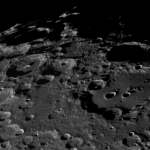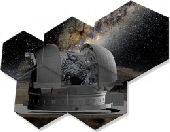In memoria del mio caro padre
Italiano:
In data 10/04/2021, ripubblico rielaborata questa mia vecchia immagine lunare di cui non ero mai rimasto particolarmente soddisfatto, per come era riuscita allora, rielaborandola a piccolissimi passi, nello scorrere di questi duri mesi di pandemia da Covid19 durante i quali ho visto spegnersi tantissimi conoscenti, amici e anche parenti molto intimi. Appunto per questo, dedico questo mio lavoro di rielaborazione di questa particolare immagine lunare, al mio caro papà che ora ci guarda da lassù. Ciao papà, grazie per quanto hai fatto per me e per la tua famiglia. Ti porteremo per sempre, con amore, nei nostri cuori.
******************************************************************************
La notte del 24 aprile 2018 è stata l’ultima di tre notti in cui qui a Palermo si è avuta una buona stabilità atmosferica per la visibilità di dettagli planetari in alta risoluzione ma, per motivi personali, ho potuto riprendere purtroppo solo l’ultima di esse (appunto il 24 aprile) in condizioni di seeing ancora accettabili (circa 6/10, in media, con punte di 7/10 della scala “Pickering”), in compagnia dell’amico astrofilo Mario lauriano. Questa che vi presento è una ripresa della zona sud Lunare, altamente craterizzata, centrata sui crateri “Moretus” e “Clavius” in cui sono evidenti, tra i maggiori crateri per dimensioni e procedendo in senso orario dall’estrema sinistra, il bel cratere a picco centrale “Schomberger”, i crateri “Simpelius” e “Curtius”, il magnifico cratere “Moretus” (quasi al centro, a picco centrale dovuto all’impatto asteroidale) con adiacente, attaccato sulla destra, il cratere “Gruemberger”, ed infine il grande cratere “Clavius” (uno dei più grandi crateri Lunari con un diametro di circa 230 km).
Clavius è anche una delle formazioni più antiche ancora visibili sulla Luna, e si è probabilmente formato circa 4 miliardi di anni or sono. Nonostante l’età, il cratere si presenta relativamente ben conservato ed il bordo è poco rilevato con al suo interno diversi crateri minori, i maggiori dei quali formano un semicerchio con ampiezze degradanti di ciascun componente.
Restano prevalentemente ancora in ombra, parzialmente illuminati dal Sole crescente e, per questo, con un aspetto a mio parere ancor più affascinante, i crateri “Newton” e “Malapert” all’estremo nord e, procedendo in senso orario, i crateri “Klaproth”, “Blancanus” (situato esattamente sopra Clavius, di cui sono visibili tutti i bordi tranne il fondo, ancora totalmente in ombra) ed infine all’estrema destra, non interamente visibile e di cui si vedono i picchi centrali su cui è sorto da poco il Sole, il cratere “Longomontanus”.
Grazie per la Vs. cortese attenzione.
Dettagli Tecnici:
Celestron C14 StarBright ad F/22 – Baader-Zeiss Abbe Barlow 2x – Baader R @ ~ 590 nm filter – GS3-U323S6M-C camera – Seeing max 6,5/10 @ 590nm band – sito: Palermo @ my personal Observatory.
****************************************************************************************************************************************************************
In loving memory of my dear father
English:
On april 10th 2021, I republish this old image of mine which I was not particularly satisfied for how it had managed then, reworking it in very small steps, in the flow of these hard months of pandemic from Covid19 during which I saw friends and even relatives, very intimate, passing due it. Precisely for this reason, I dedicate this image to my dear Dad who is now looking at us from up there. Hi dad, thank you for what you have done for me and for your family. We will carry you forever, with love, in our hearts.
***********************************
The night of 24 April 2018 was the last of three nights in which here in Palermo there was good atmospheric stability due to the visibility of planetary details in high resolution but, for personal reasons, I was unfortunately able to film only the last of they (precisely on April 24) in still acceptable seeing conditions (about 6/10, on average, with peaks of 7/10 on the “Pickering” scale), togheter with my friend Mario Lauriano. This is an image of the Lunar south, highly cratered, centered on the craters “Moretus” and “Clavius” in which are evident, among the largest craters in size and proceeding clockwise from the extreme left, the beautiful central peak crater “Schomberger”, the craters “Simpelius” and “Curtius”, the magnificent crater “Moretus” (almost in the center, with central peak due to the asteroid impact) with adjacent, attached on the right, the crater “Gruemberger”, and finally the large “Clavius” crater (one of the largest lunar craters with a diameter of about 230 km).
Clavius is also one of the oldest formations still visible on the Moon, and has probably formed about 4 billion years ago. Despite its age, the crater is relatively well preserved and the border is not very well detectable with several smaller craters inside, the largests of which form a semicircle with degrading amplitudes of each component.
They remain mostly still in the shade, partially illuminated by the growing sun and, for this reason, with an aspect that is even more fascinating in my opinion, the craters “Newton” and “Malapert” in the far north and, proceeding clockwise, the craters “Klaproth “,” Blancanus “(located exactly above Clavius, of which all edges are visible except the bottom, still totally in shadow) and finally to the extreme right, not entirely visible and of which you can see the central peaks, the crater “Longomontanus”.
Thank you for your kind attention.
Technical details:
Celestron C14 StarBright ad F/22 – Baader-Zeiss Abbe Barlow 2x – Baader R @~ 590 nm filter – GS3-U323S6M-C camera – Seeing max 6,5/10 @ 590nm band – site: Palermo @ my personal Observatory.


